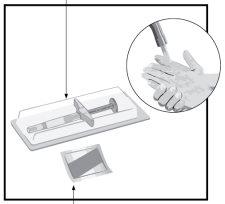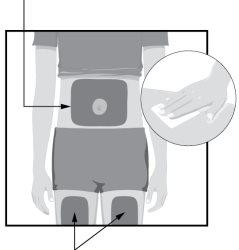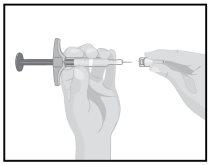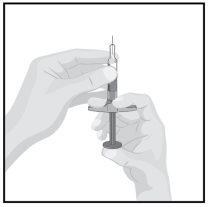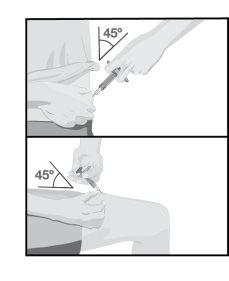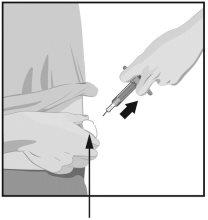
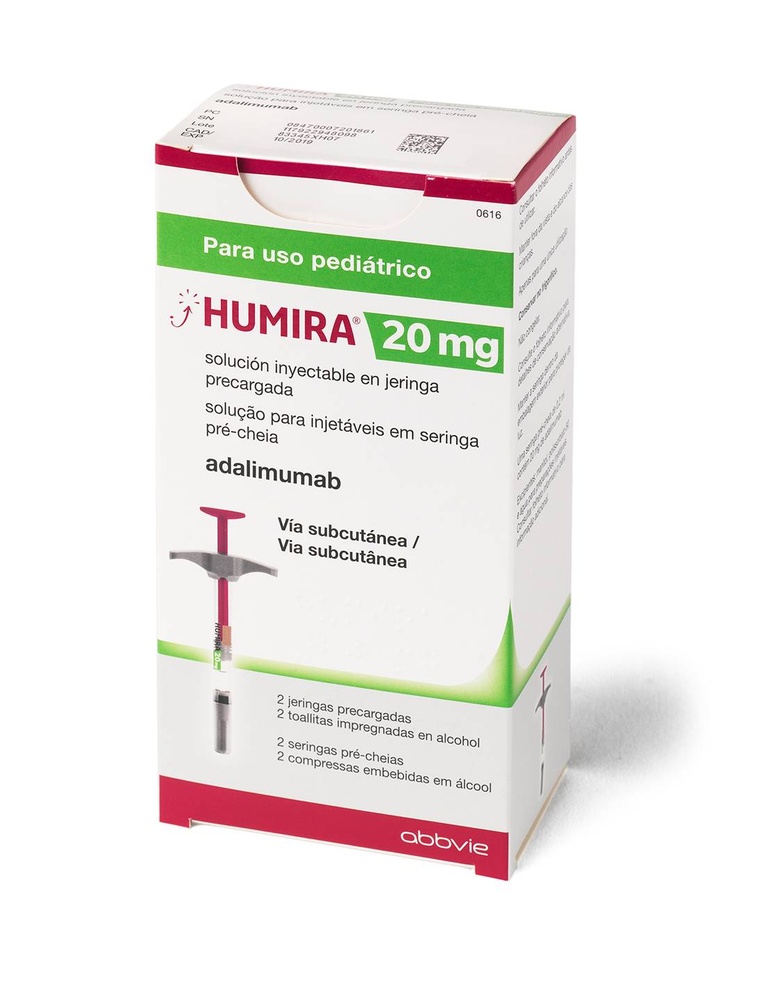
ХУМІРА 20 мг РОЗЧИН ДЛЯ ІН'ЄКЦІЙ У ПЕРЕДНАПОВНЕНИХ ШПРИЦАХ


Інструкція із застосування ХУМІРА 20 мг РОЗЧИН ДЛЯ ІН'ЄКЦІЙ У ПЕРЕДНАПОВНЕНИХ ШПРИЦАХ
Введення
Опис препарату: Інформація для пацієнта
Гуміра 20мг розчин для ін'єкцій у попередньо наповненому шприці
адалімумаб
Вважно прочитайте уважно весь опис препарату, перш ніж ваша дитина почне використовувати цей лікарський засіб, оскільки він містить важливу інформацію для вас.
- Збережіть цей опис препарату, оскільки вам може знадобитися знову його прочитати. Ваш лікар видасть вам картку інформації для пацієнта, яка містить важливу інформацію про безпеку, яку потрібно знати до та під час лікування вашої дитини Гумірою. Збережіть, ви або ваша дитина, цю картку інформації для пацієнта.
- Якщо у вас є якісь питання, проконсультуйтеся з вашим лікарем або фармацевтом.
- Цей лікарський засіб призначений лише для вашої дитини та не слід давати його іншим людям, навіть якщо вони мають такі самі симптоми, як у вашої дитини, оскільки це може зашкодити їм.
- Якщо ваша дитина відчуває побічні ефекти, проконсультуйтеся з вашим лікарем або фармацевтом, навіть якщо це побічні ефекти, які не перелічені в цьому описі препарату. Див. розділ 4.
Зміст опису препарату
- Що таке Гуміра та для чого вона використовується
- Що потрібно знати до початку використання Гуміри вашою дитиною
- Як використовувати Гуміру
- Можливі побічні ефекти
- Збереження Гуміри
- Зміст упаковки та додаткова інформація
- Як ін'єкціювати Гуміру
1. Що таке Гуміра та для чого вона використовується
Гуміра містить активну речовину адалімумаб
Гуміра призначена для лікування таких захворювань, як:
- Ювенільний ідіопатичний поліартрит
- Артрит, асоційований з ентезитом
- Псоріаз у дітей у вигляді бляшок
- Педіатрична хвороба Крона
- Педіатричний увеїт
Активна речовина Гуміри, адалімумаб, є людським моноклональним антитілом. Моноклональні антитіла - це білки, які атакують певну ціль.
Ціль адалімумабу - білок, званий фактором некрозу пухлини (TNFα), який бере участь в імунній системі (захисті) та знаходиться на високих рівнях при таких захворюваннях, як описані вище. За допомогою атаки на TNFα Гуміра зменшує процес запалення при цих захворюваннях.
Ювенільний ідіопатичний поліартрит
Ювенільний ідіопатичний поліартрит - це захворювання, яке впливає на суглоби та з'являється вперше в дитинстві.
Гуміра використовується для лікування ювенільного ідіопатичного поліартриту у дітей від 2 років. Ваша дитина могла раніше приймати інші лікарські засоби, які змінюють перебіг захворювання, такі як метотрексат. Якщо ці лікарські засоби не діють достатньо добре, ваша дитина отримує Гуміру для лікування ювенільного ідіопатичного поліартриту.
Ваш лікар вирішить, чи слід використовувати Гуміру з метотрексатом або окремо.
Артрит, асоційований з ентезитом
Артрит, асоційований з ентезитом, - це захворювання, яке впливає на суглоби та місця, де сухожилля прикріплюються до кісток.
Гуміра використовується для лікування артриту, асоційованого з ентезитом, у дітей від 6 років. Ваша дитина могла раніше приймати інші лікарські засоби, які змінюють перебіг захворювання, такі як метотрексат. Якщо ці лікарські засоби не діють достатньо добре, ваша дитина отримує Гуміру для лікування артриту, асоційованого з ентезитом.
Псоріаз у дітей у вигляді бляшок
Псоріаз у вигляді бляшок - це захворювання шкіри, яке викликає червоні, лускаті, з коростами та покриті срібними лусками ділянки. Псоріаз у вигляді бляшок також може вплинути на нігті, викликаючи їх пошкодження, загострення та відшарування від нігтьового ложа, що може бути болісним. Гуміра використовується для лікування хронічного важкого псоріазу у дітей та підлітків у віці від 4 до 17 років, які не реагують на місцеве лікування та фототерапію.
Педіатрична хвороба Крона
Хвороба Крона - це захворювання травної системи.
Гуміра використовується для лікування хвороби Крона середньої та важкої форми у дітей та підлітків у віці від 6 до 17 років.
Ваша дитина могла раніше приймати інші лікарські засоби. Якщо ці лікарські засоби не діють достатньо добре, ваша дитина отримує Гуміру для зменшення симптомів захворювання.
Педіатричний увеїт
Увеїт - це захворювання, яке впливає на певні частини ока.
Гуміра використовується для лікування дітей з хронічним увеїтом від 2 років, якщо у них є запалення, яке впливає на передню частину ока.
Це запалення може привести до зниження зору та/або появи плаваючих плям у оці (точок або ліній, які рухаються уздовж поля зору). Гуміра діє шляхом зменшення цього запалення.
Ваша дитина могла раніше приймати інші лікарські засоби. Якщо ці лікарські засоби не діють достатньо добре, ваша дитина отримує Гуміру для зменшення симптомів захворювання.
2. Що потрібно знати до початку використання Гуміри вашою дитиною
Не використовувати Гуміру:
- Якщо ваша дитина алергічна на адалімумаб або на інші компоненти цього лікарського засобу (перелічені в розділі 6).
- Якщо ваша дитина має активну туберкульозну інфекцію або іншу важку інфекцію (див. "Попередження та застереження"). Якщо ваша дитина має симптоми інфекції, наприклад, температуру, рани, втому, проблеми з зубами, важливо повідомити про це вашому лікарю.
- Якщо ваша дитина має середню або важку серцеву недостатність. важливо повідомити вашому лікарю, якщо ваша дитина мала або має серйозні проблеми з серцем (див. "Попередження та застереження").
Попередження та застереження
Проконсультуйтеся з вашим лікарем або фармацевтом, перш ніж почати використовувати Гуміру.
Алергічні реакції
- Якщо ви помітите у вашої дитини алергічну реакцію з симптомами, такими як стиск у грудній клітці, труднощі з диханням, головокружіння, набряк або висип, зупіньте введення Гуміри та негайно зверніться до вашого лікаря, оскільки ці реакції можуть бути загрозливими для життя.
Інфекції
- Якщо ваша дитина має інфекцію, включаючи хронічні або місцеві (наприклад, виразку на нозі), проконсультуйтеся з вашим лікарем, перш ніж почати лікування Гумірою. Якщо ви не впевнені, зверніться до вашого лікаря.
- Під час лікування Гумірою ваша дитина може бути більш схильна до інфекцій. Це ризик може бути вищим, якщо у вашої дитини пошкоджені легені. Ці інфекції можуть бути серйозними та включати:
- туберкульоз
- інфекції, викликані вірусами, грибами, паразитами або бактеріями
- важка інфекція в крові (сепсис)
У рідких випадках ці інфекції можуть бути загрозливими для життя. Через це важливо повідомити вашому лікарю, якщо ваша дитина має симптоми, такі як температура, рани, втома або проблеми з зубами. Ваш лікар може порадити тимчасово зупинити лікування Гумірою.
- Повідоміть вашому лікарю, якщо ваша дитина живе або подорожує до регіонів, де часто трапляються грибкові інфекції (наприклад, гістоплазмоз, кокцидіоїдоз або бластомікоз).
- Повідоміть вашому лікарю, якщо ваша дитина мала повторювані інфекції або інші фактори, які збільшують ризик інфекцій.
- Ваша дитина та ваш лікар повинні звернути особливу увагу на ознаки інфекції під час лікування Гумірою. важливо повідомити вашому лікарю, якщо ваша дитина має симптоми, такі як температура, рани, втома або проблеми з зубами.
Туберкульоз
- Оскільки були зареєстровані випадки туберкульозу у пацієнтів, які приймали Гуміру, перед початком лікування Гумірою ваш лікар перевірить ознаки та симптоми туберкульозу у вашої дитини. Це включатиме повну медичну оцінку, включаючи медичну історію вашої дитини та відповідні тести. Поведінка та результати цих тестів повинні бути записані в картці інформації для пацієнтавашої дитини.
- Важливо повідомити вашому лікарю, якщо ваша дитина мала туберкульоз або була в контакті з людиною, яка мала туберкульоз. Якщо ваша дитина має активний туберкульоз, не використовувати Гуміру.
- Туберкульоз може розвинутися під час лікування, навіть якщо ваша дитина приймала профілактичне лікування туберкульозу.
- Повідоміть вашому лікарю негайно, якщо симптоми туберкульозу (наприклад, тривала кашель, вагова недостатність, відсутність енергії, низька температура) або будь-яка інша інфекція з'являються під час або після лікування.
Гепатит Б
- Повідоміть вашому лікарю, якщо ваша дитина є носієм вірусу гепатиту Б (ВГБ), якщо мала активну інфекцію ВГБ або якщо думаєте, що вона може бути під загрозою інфекції ВГБ.
- Ваш лікар повинен провести аналіз на ВГБ. Гуміра може викликати реактивацію вірусу у людей, які є носіями ВГБ.
- У рідких випадках, особливо якщо ваша дитина приймає інші лікарські засоби, які пригнічують імунну систему, реактивація ВГБ може бути загрозливою для життя.
Хірургічна операція або стоматологічне лікування
- Якщо вашій дитині мають бути проведені хірургічна операція або стоматологічне лікування, повідоміть вашому лікарю, що вона приймає Гуміру. Ваш лікар може порадити тимчасово зупинити лікування Гумірою.
Демієлінізуючі захворювання
- Якщо ваша дитина має або розвиває демієлінізуюче захворювання (захворювання, яке впливає на оболонку навколо нервів, наприклад, множинний склероз), ваш лікар вирішить, чи слід продовжувати лікування Гумірою. Повідоміть негайно вашому лікарю, якщо ваша дитина відчуває симптоми, такі як зміни в зорі, слабкість у руках або ногах або оніміння чи поколювання в будь-якій частині тіла.
Вакцинація
- Деякі вакцини можуть викликати інфекції та не повинні бути введені, якщо проводиться лікування Гумірою.
- Проконсультуйтеся з вашим лікарем, перш ніж ваша дитина отримає будь-яку вакцину.
- Якщо це можливо, рекомендується дітям отримувати вакцини, передбачені для їхнього віку, до початку лікування Гумірою.
- Якщо ваша дитина приймала Гуміру під час вагітності, її дитина може мати більший ризик інфекції протягом приблизно п'яти місяців після останньої дози Гуміри, прийнятої під час вагітності. важливо повідомити педіатру та іншим медичним працівникам про використання Гуміри вашою дитиною під час вагітності, щоб вони могли вирішити, чи слід дитині отримувати будь-яку вакцину.
Серцева недостатність
- Якщо ваша дитина має легку серцеву недостатність та приймає Гуміру, вона може бути під sátним спостереженням вашого лікаря. важливо повідомити вашому лікарю, якщо ваша дитина мала або має серйозні проблеми з серцем. Якщо ваша дитина розвиває нові симптоми або погіршення симптомів (труднощі з диханням, набряк ніг), вона повинна негайно звернутися до вашого лікаря. Ваш лікар вирішить, чи слід продовжувати лікування Гумірою.
Температура, гематоми, кровотеча або блідість
- У деяких пацієнтів організм може бути нездатний виробляти достатню кількість певних типів клітин крові, які допомагають організму боротися з інфекціями або зупиняти кровотечу. Ваш лікар може вирішити зупинити лікування. Якщо ваша дитина розвиває тривалу температуру, легкі гематоми або кровотечу або має блідий вигляд, негайно зверніться до вашого лікаря.
Рак
- У дуже рідких випадках були зареєстровані випадки певних типів раку у дітей та дорослих, які приймали Гуміру або інші засоби, які блокують TNF.
- Люди з ревматоїдним артритом більшої тяжкості та тривалості захворювання можуть мати більший ризик розвитку лімфоми (раку, який впливає на лімфатичну систему) та лейкемії (раку, який впливає на кров та кістковий мозок).
- Якщо ваша дитина приймає Гуміру, ризик розвитку лімфоми, лейкемії та інших типів раку може збільшитися. Був спостережений рідкий та серйозний тип лімфоми у пацієнтів, які приймали Гуміру. Деякі з цих пацієнтів також приймали азатіоприн або 6-меркаптопурин.
- Повідоміть вашому лікарю, якщо ваша дитина приймає азатіоприн або 6-меркаптопурин з Гумірою.
- Були зареєстровані випадки раку шкіри (не-меланомного типу) у пацієнтів, які приймали Гуміру.
- Повідоміть вашому лікарю, якщо під час або після лікування з'являються нові ураження шкіри або якщо існуючі ураження змінюють свій вигляд.
- Були зареєстровані випадки раку, khácного від лімфоми, у пацієнтів з певним захворюванням легенів, відомим як хронічна обструктивна захворювання легенів (ХОЗЛ), які приймали інші засоби, які блокують TNF. Якщо ваша дитина має ХОЗЛ або палить багато, вона повинна проконсультуватися з вашим лікарем, чи підходить лікування засобами, які блокують TNF, для вашої дитини.
Аутоімунне захворювання
- У рідких випадках лікування Гумірою може викликати синдром, подібний до системного червоного вовчака. Зверніться до вашого лікаря, якщо у вашої дитини з'являються симптоми, такі як тривала висипка, температура, боль у суглобах або втома.
Використання Гуміри з іншими лікарськими засобами
Повідоміть вашому лікарю або фармацевту, якщо ваша дитина приймає, нещодавно приймала або може приймати будь-які інші лікарські засоби.
Ваша дитина не повинна приймати Гуміру з іншими лікарськими засобами, які містять такі активні речовини через підвищений ризик серйозних інфекцій:
- анакінра
- абатацепт.
Гуміра може бути прийнята разом з:
- метотрексатом
- певними лікарськими засобами, які змінюють перебіг захворювання (наприклад, сульфасалазином, гідроксихлорохіном, лефлуномідом та ін'єкційними препаратами на основі солей золота)
- стероїдами або лікарськими засобами для лікування болю, включаючи нестероїдні протизапальні засоби (НПЗ).
Якщо у вас є якісь питання, проконсультуйтеся з вашим лікарем.
Вагітність та лактація
- Ваша дитина повинна розглянути використання відповідних методів контрацепції, щоб уникнути вагітності та продовжувати їх використання протягом至少 5 місяців після останнього лікування Гумірою.
- Якщо ваша дитина вагітна, думає, що може бути вагітною або планує мати дитину, вона повинна проконсультуватися з вашим лікарем про використання цього лікарського засобу.
- Гуміра повинна бути використана під час вагітності лише за необхідності.
- За даними одного дослідження під час вагітності, не було збільшення ризику вроджених дефектів, коли мати приймала лікування Гумірою під час вагітності порівняно з матерями з тим самим захворюванням, які не приймали лікування Гумірою.
- Гуміра може бути використана під час лактації.
- Якщо ваша дитина приймала Гуміру під час вагітності, її дитина може мати більший ризик інфекції.
- Важливо повідомити педіатру та іншим медичним працівникам про використання Гуміри вашою дитиною під час вагітності, щоб вони могли вирішити, чи слід дитині отримувати будь-яку вакцину.
Відновлення та використання машин
Вплив Гуміри на здатність вашої дитини керувати транспортними засобами, їздити на велосипеді або використовувати машини є малим. Можуть виникнути відчуття, що кімната обертається, та порушення зору після використання Гуміри.
3. Як використовувати Гуміру
Слідкуйте точно інструкціям щодо застосування цього лікарського засобу, вказаним вашим лікарем або фармацевтом. У разі сумнівів проконсультуйтеся знову з вашим лікарем або фармацевтом.
Рекомендовані дози Гуміри для кожної з затверджених показань наведені в наступній таблиці. Ваш лікар може призначити іншу дозу Гуміри, якщо ваша дитина потребує іншої дози.
Ювенільний ідіопатичний поліартрит | ||
Вік або маса тіла | Яка доза та з якою частотою її слід приймати | Примітки |
Діти, підлітки та дорослі від 2 років з масою тіла 30 кг або більше | 40 мг кожні 2 тижні | Не застосовується |
Діти та підлітки від 2 років з масою тіла від 10 кг до 30 кг | 20 мг кожні 2 тижні | Не застосовується |
Артрит, асоційований з ентезитом | ||
Вік або маса тіла | Яка доза та з якою частотою її слід приймати | Примітки |
Діти, підлітки та дорослі від 6 років з масою тіла 30 кг або більше | 40 мг кожні 2 тижні | Не застосовується |
Діти та підлітки від 6 років з масою тіла від 15 кг до 30 кг | 20 мг кожні 2 тижні | Не застосовується |
Педіатричний псоріаз у плаці | ||
Вік або маса тіла | Яка доза та з якою частотою її слід приймати | Примітки |
Діти та підлітки від 4 до 17 років з масою тіла 30 кг або більше | Початкова доза становить 40 мг, за якою слідує 40 мг через тиждень. Потім звичайна доза становить 40 мг кожні 2 тижні. | Не застосовується |
Діти та підлітки від 4 до 17 років з масою тіла від 15 кг до 30 кг | Початкова доза становить 20 мг, за якою слідує 20 мг через тиждень. Потім звичайна доза становить 20 мг кожні 2 тижні. | Не застосовується |
Педіатрична хвороба Крона | ||
Вік або маса тіла | Яка доза та з якою частотою її слід приймати | Примітки |
Діти та підлітки від 6 до 17 років з масою тіла 40 кг або більше | Початкова доза становить 80 мг, за якою слідує 40 мг через 2 тижні. Якщо потрібна швидша реакція, ваш педіатр може призначити початкову дозу 160 мг, за якою слідує 80 мг через 2 тижні. Потім звичайна доза становить 40 мг кожні 2 тижні. | Ваш педіатр може збільшити дозу до 40 мг кожну тиждень або 80 мг кожні 2 тижні. |
Діти та підлітки від 6 до 17 років з масою тіла менше 40 кг | Початкова доза становить 40 мг, за якою слідує 20 мг через 2 тижні. Якщо потрібна швидша реакція, лікар може призначити початкову дозу 80 мг, за якою слідує 40 мг через 2 тижні. Потім звичайна доза становить 20 мг кожні 2 тижні. | Ваш педіатр може збільшити частоту дози до 20 мг кожну тиждень. |
Педіатричний увеїт | ||
Вік або маса тіла | Яка доза та з якою частотою її слід приймати | Примітки |
Діти та підлітки від 2 років з масою тіла менше 30 кг | 20 мг кожні 2 тижні | Ваш лікар може призначити початкову дозу 40 мг, яка може бути введена за тиждень до початку звичайної схеми 20 мг кожні 2 тижні. Рекомендується використання Гуміри в поєднанні з метотрексатом. |
Діти та підлітки від 2 років з масою тіла 30 кг або більше | 40 мг кожні 2 тижні | Ваш лікар може призначити початкову дозу 80 мг, яка може бути введена за тиждень до початку звичайної схеми 40 мг кожні 2 тижні. Рекомендується використання Гуміри в поєднанні з метотрексатом. |
Форма та шлях введення
Гуміру вводять під шкіру (підшкірно).
У розділі 7 «Як вводити Гуміру» наведені інструкції щодо введення ін'єкції Гуміри.
Якщо ви використали більше Гуміри, ніж потрібно
Якщо випадково ввели Гуміру з більшою частотою, ніж призначив лікар або фармацевт, ви повинні зателефонувати лікарю або фармацевту та повідомити їм, що ваша дитина використала більше. Зawsше носіть з собою коробку з лікарським засобом, навіть якщо вона порожня.
Якщо ви забули використати Гуміру
Якщо ви забули зробити ін'єкцію вашій дитині, ви повинні ввити наступну дозу Гуміри як тільки ви про це пам'ятайте. Потім введіть наступну дозу, як зазвичай, так, як якщо б ви не забули про дозу.
Якщо ви припинили лікування Гумірою
Рішення про припинення використання Гуміри повинно бути обговорено з вашим лікарем. Симптоми вашої дитини можуть повернутися після припинення лікування.
Якщо у вас є будь-які інші питання щодо використання цього лікарського засобу, проконсультуйтеся з вашим лікарем або фармацевтом.
4. Можливі побічні ефекти
Як і всі лікарські засоби, цей лікарський засіб може викликати побічні ефекти, хоча не всі люди їх відчувають. Більшість побічних ефектів є легкими або помірними. Однак деякі з них можуть бути серйозними та вимагати лікування. Побічні ефекти можуть виникнути принаймні через 4 місяці після останньої ін'єкції Гуміри.
Зв'яжіться з вашим лікарем негайно, якщо ви помітите будь-які з наступних ефектів
- серйозна висипка, кропив'янка або інші ознаки алергічної реакції
- набряк обличчя, рук, ніг
- затруднення дихання, ковтання
- брак повітря під час фізичних вправ або лежачи, набряк ніг
Зв'яжіться з вашим лікарем якомога швидше, якщо ви помітите будь-які з наступних ефектів
- ознаки інфекції, такі як гарячка, нудота, рани, стоматологічні проблеми, відчуття печіння під час сечовипускання
- відчуття слабкості або втоми
- кашель
- поколювання
- оніміння
- двоїння зору
- слабкість у руках або ногах
- виступ або відкрита рана, яка не загоюється
- ознаки та симптоми порушень у крові, такі як тривала гарячка, синяки, кровотечі та блідість
Симптоми, описані вище, можуть бути ознаками побічних ефектів, перелічених нижче, які були спостережені при застосуванні Гуміри.
Дуже часті(можуть виникнути у більш ніж 1 з 10 осіб)
- реакції на місці ін'єкції (включаючи біль, набряк, червоність або свербіж)
- інфекції нижніх дихальних шляхів (включаючи застуду, риніт, синусит, пневмонію)
- головний біль
- біль у животі
- нудота та блювота
- висипка
- біль у м'язах
Часті(можуть виникнути у до 1 з 10 осіб)
- серйозні інфекції (включаючи сепсис та грип)
- інфекції кишечника (включаючи гастроентерит)
- інфекції шкіри (включаючи целюліт та герпес)
- інфекція вуха
- інфекції ротової порожнини (включаючи інфекцію зубів та біль у горлі)
- інфекції репродуктивної системи
- інфекція сечовивідних шляхів
- грибкові інфекції
- інфекція суглобів
- доброякісні пухлини
- рак шкіри
- алергічні реакції (включаючи сезонну алергію)
- зневоднення
- зміни настрою (включаючи депресію)
- тривога
- затруднення засинання
- порушення чутливості, такі як поколювання, свербіж або оніміння
- мігрень
- стиснення корінців нервів (включаючи біль у нижній частині спини та ноги)
- порушення зору
- воспалення ока
- воспалення повік та набряк ока
- вертіго (відчуття головокружіння або того, що все обертається)
- відчуття прискореного серцебиття
- високий кров'яний тиск
- рубець
- гематома (накопичення крові поза кровоносними судинами)
- кашель
- астма
- затруднення дихання
- кровотеча з шлунково-кишкового тракту
- диспепсія (розтройство шлунку, надмірна піна та печіння)
- кислотний рефлюкс
- синдром сухого ока (включаючи сухість очей та рота)
- свербіж
- висипка з свербіжем
- синяки
- воспалення шкіри (як екзема)
- лущення нігтів на руках та ногах
- збільшення потовиділення
- втата волосся
- псоріаз нового виникнення або погіршення існуючого псоріазу
- м'язові спазми
- кров у сечі
- проблеми з нирками
- біль у грудній клітці
- набряк (набряк)
- гарячка
- зниження кількості тромбоцитів у крові, що збільшує ризик кровотечі або синяків
- проблеми з загоєнням ран
Рідкі(можуть виникнути у до 1 з 100 осіб)
- опортуністичні інфекції (включаючи туберкульоз та інші інфекції, які виникають, коли знижується опірність організму)
- нейрологічні інфекції (включаючи вірусний менінгіт)
- інфекції ока
- бактеріальні інфекції
- дивертикуліт (воспалення та інфекція товстої кишки)
- пухлина
- пухлина, що впливає на лімфатичну систему
- меланома
- імунологічні порушення, які можуть вплинути на легені, шкіру та лімфатичні вузли (найбільш поширена форма - саркоїдоз)
- васкуліт (воспалення кровоносних судин)
- тремор (відчуття тремтіння)
- нейропатія (розлад нервів)
- інсульт
- втрата слуху, шум у вухах
- відчуття нерегулярного серцебиття, як стрибки
- проблеми з серцем, які можуть викликати затруднення дихання або набряк гомілок
- серцевий напад
- мішок на стінці великої артерії, запалення та згортання крові в вені, блокування кровоносного судини
- легеневі захворювання, які можуть викликати затруднення дихання (включаючи запалення)
- легенева емболія (блокування легеневої артерії)
- плевральний випот (анормальне накопичення рідини в плевральній порожнині)
- воспалення підшлункової залози, яке викликає сильний біль у животі та спині
- затруднення ковтання
- набряк обличчя (набряк обличчя)
- воспалення жовчного міхура, камені в жовчному міхурі
- жир у печінці
- нічні поти
- шрами
- м'язові спазми
- синдром Лайма (включаючи висипку та м'язову слабкість)
- перебої у сні
- імпотенція
- воспалення
Рідкісні(можуть виникнути у до 1 з 1000 осіб)
- лейкоз (рак, який впливає на кров та кістковий мозок)
- серйозна алергічна реакція з шоком
- розсіяний склероз
- нейрологічні порушення (як запалення зорового нерва та синдром Гієна-Барре, який може викликати м'язову слабкість, ненормальні відчуття, поколювання в руках та верхній частині тіла)
- серцевий напад
- легенева фіброз (шрам на легенях)
- перфорація кишечника
- гепатит
- реактивація вірусу гепатиту Б
- автоімунний гепатит (воспалення печінки, викликані власною імунною системою організму)
- васкуліт шкіри (воспалення кровоносних судин шкіри)
- синдром Стівенса-Джонсона (перші симптоми включають нездужання, гарячку, головний біль та висипку)
- набряк обличчя (воспалення обличчя), пов'язаний з алергічними реакціями
- еритема мультиформна (висипка на шкірі)
- синдром, подібний до системного червоного вовчака
- ангіоневротичний набряк (локалізоване запалення шкіри)
- ліхеноподібна реакція на шкірі (червоний-пурпурний висип з свербіжем)
Частота невідома(частота не може бути оцінена з наявних даних)
- гепатоспленічний Т-клітинний лімфом (рідкий смертельний рак крові)
- карцинома Меркеля (рідкий тип раку шкіри)
- саркома Капоші, рідкий тип раку, пов'язаний з інфекцією вірусом людського герпесу 8. Саркома Капоші зазвичай проявляється як червоні плями на шкірі
- негодження печінки
- погіршення захворювання, відомого як дерматоміозит (висипка на шкірі, супроводжувана м'язовою слабкістю)
- збільшення ваги (для більшості пацієнтів збільшення ваги було зменшено)
Деякі побічні ефекти, спостережені у клінічних дослідженнях, не мають симптомів і можуть бути виявлені лише за допомогою аналізу крові. До них належать:
Дуже часті(можуть виникнути у більш ніж 1 з 10 осіб)
- низький рівень лейкоцитів у крові
- низький рівень червоних кров'яних тілець у крові
- збільшення рівня ліпідів у крові
- збільшення рівня печінкових ферментів
Часті(можуть виникнути у до 1 з 10 осіб)
- високий рівень лейкоцитів у крові
- низький рівень тромбоцитів у крові
- збільшення рівня сечовини у крові
- анормальні рівні натрію у крові
- низький рівень кальцію у крові
- низький рівень фосфору у крові
- високий рівень цукру у крові
- високий рівень лактатдегідрогенази у крові
- присутність аутоантитіл у крові
- низький рівень калію у крові
Рідкі(можуть виникнути у до 1 з 100 осіб)
- підвищені рівні білірубіну (аналіз функції печінки)
Рідкісні(можуть виникнути у до 1 з 1000 осіб)
- низький рівень лейкоцитів, червоних кров'яних тілець та тромбоцитів у крові
Звіт про побічні ефекти
Якщо ваша дитина відчуває будь-який побічний ефект, проконсультуйтеся з вашим лікарем або фармацевтом, навіть якщо це можливі побічні ефекти, які не наведені в цьому листку. Ви також можете повідомити про них безпосередньо через національну систему повідомлень, включену до додатка V. Надсилаючи повідомлення про побічні ефекти, ви можете допомогти надати більше інформації про безпеку цього лікарського засобу.
5. Зберігання Гуміри
Тримайте цей лікарський засіб поза зоною досяжності дітей.
Не використовувати цей лікарський засіб після закінчення терміну придатності, вказаного на етикетці/блістері/коробці після «CAD».
Зберігати у холодильнику (між 2°C та 8°C). Не заморожувати.
Зберігати попередньо заповнену шприц у зовнішній упаковці, щоб захистити її від світла.
Альтернативне зберігання:
Коли це необхідно (наприклад, під час поїздки), ви можете зберігати одну попередньо заповнену шприц Гуміри при кімнатній температурі (до 25°C) протягом максимального періоду 14 днів - переконайтеся, що ви захистили її від світла. Як тільки ви вийняли шприц з холодильника для зберігання при кімнатній температурі, ви повинні використовувати його протягом наступних 14 днів або викинути, навіть якщо ви знову помістите його у холодильник.
Ви повинні записати дату, коли ви вийняли шприц з холодильника, та дату, після якої ви повинні викинути шприц.
Лікарські засоби не повинні викидатися у каналізацію або сміття. Спитайте у вашого лікаря або фармацевта, як позбутися упаковок та лікарських засобів, які вам більше не потрібні. Таким чином, ви допоможете захистити довкілля.
6. Зміст упаковки та додаткова інформація
Склад Хуміри
Активний інгредієнт - адалімумаб.
Інші компоненти - манітол, полісорбат 80 та вода для ін'єкційних препаратів.
Вигляд продукту та вміст упаковки
Хуміра 20 мг розчин для ін'єкцій у попередньо заповненому шприці для педіатричного використання поставляється у вигляді стерильного розчину, який містить 20 мг адалімумабу, розчиненого у 0,2 мл розчину.
Попередньо заповнений шприц Хуміри - це скляний шприц, який містить розчин адалімумабу.
Попередньо заповнений шприц Хуміри доступний в упаковці, яка містить 2 попередньо заповнені шприци з 2 ватними тампонами, змоченими спиртом.
Хуміра також доступна у вигляді флакона, попередньо заповненого шприца та/або попередньо заповненої ручки.
Власник дозволу на торгівлю
AbbVie Deutschland GmbH & Co. KG
Knollstrasse
67061 Людвігсгафен
Німеччина
Виробник
AbbVie Biotechnology GmbH
Knollstrasse
67061 Людвігсгафен
Німеччина
Для отримання додаткової інформації щодо цього лікарського засобу зверніться до місцевого представника власника дозволу на торгівлю.
Бельгія/Бельгія/Бельгія AbbVie SA Тел./Телефон: +32 10 477811 | Литва AbbVie UAB Телефон: +370 5 205 3023 |
Болгарія AbbVie ЕООД Телефон: +359 2 90 30 430 | Люксембург/Люксембург AbbVie SA Бельгія/Бельгія Тел./Телефон: +32 10 477811 |
Чехія AbbVie s.r.o. Телефон: +420 233 098 111 | Угорщина AbbVie Kft. Телефон: +36 1 455 8600 |
Данія AbbVie A/S Телефон: +45 72 30-20-28 | Мальта V.J.Salomone Pharma Limited Телефон: +356 21220174 |
Німеччина AbbVie Deutschland GmbH & Co. KG Телефон: 00800 222843 33 (безкоштовно) Телефон: +49 (0) 611 / 1720-0 | Нідерланди AbbVie B.V. Телефон: +31 (0)88 322 2843 |
Естонія AbbVie OÜ Телефон: +372 623 1011 | Норвегія AbbVie AS Телефон: +47 67 81 80 00 |
Греція AbbVie ΦΑΡΜΑΚΕΥΤΙΚΗ Α.Ε. Телефон: +30 214 4165 555 | Австрія AbbVie GmbH Телефон: +43 1 20589-0 |
Іспанія AbbVie Spain, S.L.U. Телефон: +34 91 384 09 10 | Польща AbbVie Polska Sp. z o.o. Телефон: +48 22 372 78 00 |
Франція AbbVie Телефон: +33 (0) 1 45 60 13 00 | Португалія AbbVie, Lda. Телефон: +351 (0)21 1908400 |
Хорватія AbbVie d.o.o. Телефон: + 385 (0)1 5625 501 | Румунія AbbVie S.R.L. Телефон: +40 21 529 30 35 |
Ірландія AbbVie Limited Телефон: +353 (0)1 4287900 | Словенія AbbVie Biofarmacevtska družba d.o.o. Телефон: +386 (1)32 08 060 |
Ісландія Vistor hf. Телефон: +354 535 7000 | Словаччина AbbVie s.r.o. Телефон: +421 2 5050 0777 |
Італія AbbVie S.r.l. Телефон: +39 06 928921 | Фінляндія AbbVie Oy Телефон: +358 (0) 10 2411 200 |
Кіпр Lifepharma (Z.A.M.) Ltd Телефон: +357 22 34 74 40 | Швеція AbbVie AB Телефон: +46 (0)8 684 44 600 |
Латвія AbbVie SIA Телефон: +371 67605000 |
Дата останнього перегляду цієї інструкції
Детальна інформація про цей лікарський засіб доступна на сайті Європейського агентства з лікарських засобів: http://www.ema.europa.eu.
Для отримання цієї інструкції вбрайлі, великому шрифті або для прослуховування в аудіоформатізверніться до місцевого представника власника дозволу на торгівлю.
- Як вводити Хуміру
- Наступні інструкції пояснюють, як вводити Хуміру підшкірно за допомогою попередньо заповненого шприца. Важливо прочитати всі інструкції перед тим, як почати, а потім слідувати їм крок за кроком.
- Ваш лікар, медсестра або фармацевт покаже вам техніку ін'єкції.
- Не намагайтесь зробити ін'єкцію, поки не будете впевнені, що розумієте, як підготувати та зробити ін'єкцію.
- Після того, як вас правильно навчають, ваша дитина або інша особа, наприклад, член сім'ї чи друг, можуть зробити ін'єкцію.
- Використовуйте кожен попередньо заповнений шприц тільки для однієї ін'єкції.
Хуміра попередньо заповнений шприц
ПоршеньКрила затримкиНаконечник голки
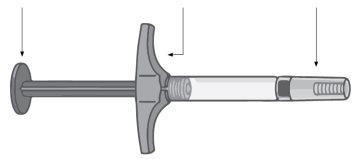
Не використовуйте попередньо заповнений шприц і зверніться до вашого лікаря або фармацевта, якщо
- рідина є мутною, забарвленою або містить лусочки чи частинки
- мінімізована дата закінчення терміну зберігання (CAD)
- рідина була заморожена або залишена на прямому сонячному світлі
- попередньо заповнений шприц був упущений або розчавлений
Не знімайте наконечник голки до самого моменту ін'єкції. Тримайте Хуміру поза зоною видимості та доступу дітей.
КРОК1 Видаліть Хуміру з холодильника. Залиште Хуміру при кімнатній температурі між 15 і 30хвилинамиперед ін'єкцією.
| |
КРОК2 Шприц
Ватний тампон | Перевірте дату закінчення терміну зберігання (CAD). Невикористовуйте попередньо заповнений шприц, якщо дата закінчення терміну зберігання (CAD) вже минула. На гладкій і чистій поверхні розмістіть
Вимийте руки та висушіть їх. |
КРОК3 Місця ін'єкції
Місця ін'єкції | Виберіть місце на тілі для ін'єкції:
Очистіть місце ін'єкції ватним тампоном, змоченим спиртом, рухами по колу.
|
КРОК4
| Тримайте попередньо заповнений шприц однією рукою. Перевірте рідину в попередньо заповненому шприці.
Обережно знімайте наконечник голки другою рукою. Витягніть наконечник голки та не використовуйте його знову.
|
КРОК5
| Тримайте попередньо заповнений шприц з голкою, спрямованою вгору.
Повільно натисніть на поршень, щоб видалити повітря через голку
|
КРОК6
| Тримайте тіло попередньо заповненого шприца однією рукою між великим та вказівним пальцями, як би ви тримали ручку. Зігніть шкіру в місці ін'єкції другою рукою, щоб вона піднялася, та тримайте її міцно. |
КРОК7
| Вставте голку в шкіру під кутом приблизно 45 градусів з коротким та швидким рухом.
Повільно натисніть на поршень до кінця, поки весь ліків не буде введено та попередньо заповнений шприц не буде порожнім. |
КРОК8
Ватний тампон | Після завершення ін'єкції повільно вийміть голку зі шкіри, тримаючи попередньо заповнений шприц під тим же кутом. Після завершення ін'єкції помістіть ватний тампон або гасу на шкіру в місці ін'єкції.
|
КРОК9 Викиньте попередньо заповнений шприц у контейнер для спеціальних відходів згідно з інструкціями вашого лікаря, медсестри або фармацевта. Ніколине повертайте наконечник голки на голку.
Наконечник голки, ватний тампон, гаса, блистер та упаковка можуть бути викинуті у домашній сміттєвий бак. |
- Країна реєстрації
- Діючі речовини
- Потрібен рецептТак
- Виробник
- Інформація є довідковою і не є медичною порадою. Перед прийомом будь-яких препаратів обов'язково проконсультуйтеся з лікарем. Oladoctor не несе відповідальності за медичні рішення, прийняті на основі цього контенту.
- Альтернативи до ХУМІРА 20 мг РОЗЧИН ДЛЯ ІН'ЄКЦІЙ У ПЕРЕДНАПОВНЕНИХ ШПРИЦАХФорма випуску: РОЗЧИН ДЛЯ ІН'ЄКЦІЙ, 20 мгДіючі речовини: adalimumabВиробник: Amgen Europe B.V.Потрібен рецептФорма випуску: РОЗЧИН ДЛЯ ІН'ЄКЦІЙ, 20 мгДіючі речовини: adalimumabВиробник: Amgen Europe B.V.Потрібен рецептФорма випуску: РОЗЧИН ДЛЯ ІН'ЄКЦІЙ, 40 мгДіючі речовини: adalimumabВиробник: Amgen Europe B.V.Потрібен рецепт
Аналоги ХУМІРА 20 мг РОЗЧИН ДЛЯ ІН'ЄКЦІЙ У ПЕРЕДНАПОВНЕНИХ ШПРИЦАХ в інших країнах
Найкращі аналоги з тією самою діючою речовиною та терапевтичним ефектом.
Аналог ХУМІРА 20 мг РОЗЧИН ДЛЯ ІН'ЄКЦІЙ У ПЕРЕДНАПОВНЕНИХ ШПРИЦАХ у Ukraine
Лікарі онлайн щодо ХУМІРА 20 мг РОЗЧИН ДЛЯ ІН'ЄКЦІЙ У ПЕРЕДНАПОВНЕНИХ ШПРИЦАХ
Консультація щодо дозування, побічних ефектів, взаємодій, протипоказань та поновлення рецепта на ХУМІРА 20 мг РОЗЧИН ДЛЯ ІН'ЄКЦІЙ У ПЕРЕДНАПОВНЕНИХ ШПРИЦАХ – за рішенням лікаря та згідно з місцевими правилами.



